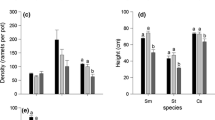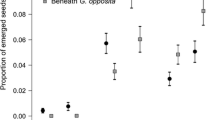Abstract
The relative importance of positive and negative interaction in species assemblages is thought to be dependent on the harshness of the physical environment. I studied the consistency of this prediction in a field experiment using growth of the target species Warnstorfia exannulata as influenced by the presence or absence of two adjacent species, Sphagnum warnstorfii and Scapania undulata. In particular, I focused on the mechanism by which colony–colony interactions occur, elucidating how the balance of positive and negative interactions changes along a water gradient. Because the natural fluctuations of the environment modify the water gradient, it was expected that the competitive hierarchies of the species would not remain consistent over time. Results indicated that the different hydrological properties of the colonies, thought to be the necessary condition for the appearance of species interactions, were not sufficient to explain the outcome of the species interactions. The switch from competition to facilitation under more stressful conditions was not confirmed along a water stress gradient. In addition, natural climatic fluctuations, by affecting the length of the water gradient, changed the competitive hierarchies of the species on a seasonal scale.







Similar content being viewed by others
References
Armas C, Ordiales R, Pugnaire F (2004) Measuring plant interaction: a new comparative index. Ecology 85:2682–2686
Bertness MD, Callaway R (1994) Positive interaction in communities. Trends Ecol Evol 9:191–193
Birse E (1957) Ecological studies of growth-form in bryophytes III. The relationship between the growth-form of mosses and ground-water level supply. J Ecol 46:9–27
Brooker RW, Maestre FT, Callaway RM, Lortie CL, Cavieres LA, Kunstler G, Liancourt P, Tielborger K, Travis JMJ, Anthelme F, Armas C, Coll L, Corcket E, Delzon S, Forey E, Kikvidze Z, Olofsson J, Pugnaire F, Quiroz CL, Saccone P, Schiffers K, Seifan M, Touzard B, Michalet R (2008) Facilitation in plant communities: the past, the present, and the future. J Ecol 96:18–34
Bruno JF, Stachowicz JJ, Bertness MD (2003) Inclusion of facilitation into ecological theory. Trends Ecol Evol 18:119–125
Callaway RM, Walker LR (1997) Competition and facilitation: a synthetic approach to interactions in plant community. Ecology 78:1958–1965
Callaway RM, Brooker RW, Choler P, Kikvidze Z, Lortie CJ, Michalet R, Paolini L, Pugnaire FI, Newingham B, Aschehoug ET, Armas C, Kikodze D, Cook BJ (2002) Positive interactions among alpine plants increase with stress. Nature 417:844–848
Cantonati M, Gerecke R, Bertuzzi E (2006) Springs of the Alps, sensitive ecosystems to environmental change: from biodiversity assessments to long-term studies. Hydrobiologia 562:59–96
Choler P, Michalet R, Callaway RM (2001) Facilitation and competition on gradients in Alpine plant communities. Ecology 82:3295–3308
Fortin MJ, Dale MRT (2005) Spatial analysis: a guide for ecologists. Cambridge University Press, Cambridge
Gimingham CH, Birse E (1957) Ecological studies of growth-form in bryophytes I. Correlation between growth-form and habitat. J Ecol 45:433–445
Glasby TM (1997) Analysing data from post-impact studies using asymmetrical analyses of variance: a case study of epibiota on marinas. Aust J Ecol 22:448–459
Glime J (2007) Bryophyte ecology, vol 1. Physiological ecology. Ebook sponsored by Michigan Technological University and the International Association of Bryologists. Accessed 09 May 2008. htpp://www.bryoecol.mtu.edu/
Greenlee JT, Callaway RM (1996) Abiotic stress and the relative importance of interference and facilitation in montane bunchgrass communities in western Montana. Am Nat 148:386–396
Hunter AF, Aarssen LW (1988) Plants helping plants. Bioscience 38:34–40
James SE, Pärtel M, Wilson SD, Peltzer DA (2003) Temporal heterogeneity of soil moisture in grassland and forest. J Ecol 91:234–239
Kikvidze Z, Khetsuriani L, Kikodze D, Callaway RM (2006) Seasonal shifts in competition and facilitation in subalpine plant communities of the central Caucasus. J Veg Sci 17:77–82
Kitzberger T, Steinaker DF, Veblen T (2000) Effects of climatic variability on facilitation of tree establishment in Northern Patagonia. Ecology 81:1914–1924
Legendre P, Legendre L (1998) Numerical ecology, 2nd English edn. Elsevier, Amsterdam
Levine JM (1999) Indirect facilitation: evidence and predictions from a riparian community. Ecology 80:1762–1769
Liancourt P, Callaway RM, Michalet R (2005) Stress tolerance and competitive-response ability determine the outcome of biotic interactions. Ecology 86:1611–1618
Lortie CJ, Callaway RM (2006) Re-analysis of meta-analysis: support for the stress-gradient hypothesis. J Ecol 94:7–16
Maestre FT, Cortina J (2004) Do positive interactions increase with abiotic stress? A test from a semi-arid steppe. Proc R Soc Lond B 271:331–333
Maestre FT, Valladares F, Reynolds JF (2006) The stress-gradient hypothesis does not fit all relationships between plant–plant interactions and abiotic stress: further insights from arid environments. J Ecol 94:17–22
Marino PC (1991) Competition between mosses (Splachnaceae) in patchy habitats. J Ecol 79:1031–1046
Michalet R, Brooker RW, Cavieres LA, Kikvidze Z, Lortie CJ, Pugnaire FI, Valiente-Banuet A, Callaway RM (2006) Do biotic interactions shape both sides of the humped-back model of species richness in plant communities? Ecol Lett 9:767–773
Mitchell RT, Zutter BR, Green TH, Perry MA, Gjerstad DH (1993) Spatial and temporal variation in competitive effects on soil moisture and pine response. Ecol Appl 3:167–174
Mulder CPH, Uliassi DD, Doak DF (2001) Physical stress and diversity–productivity relationships: the role of positive interactions. Proc Natl Acad Sci USA 98:6704–6708
Oksanen L, Sammul M, Mägi M (2006) On the indices of plant–plant competition and their pitfalls. Oikos 112:149–155
Pedersen B, Hanslin HM, Bakken S (2001) Testing for positive density-dependent performance in four bryophyte species. Ecology 82:70–88
Proctor MCF (2000) Mosses and alternative adaptation to life in land. New Phytol 148:1–6
Proctor MCF, Tuba Z (2002) Poikilohydry and homoihydry: antithesis or spectrum of possibilities? New Phytol 156:327–349
Pugnaire F, Luque MT (2001) Changes in plant interactions along a gradient of environmental stress. Oikos 93:42–49
Rincon E, Grime JP (1989) An analysis of seasonal patterns of bryophyte growth in a natural habitat. J Ecol 77:447–455
Rixen C, Mulder CPH (2005) Improved water retention links high species richness with increased productivity in arctic tundra moss communities. Oecologia 146:287–299
Rydin H (1997) Competition among bryophytes. Adv Bryol 6:135–168
Sthultz CM, Gehring CA, Whitham T (2007) Shifts from competition to facilitation between a foundation tree and a pioneer shrub across spatial and temporal scales in a semiarid woodland. New Phytol 173:135–145
Tielborger K, Kadmon R (2000) Temporal environmental variation tips the balance between facilitation and interference in desert plants. Ecology 81:1544–1553
Travis JMJ, Brooker RW, Clark EJ, Dytham C (2006) The distribution of positive and negative species interactions across environmental gradients on a dual-lattice model. J Theor Biol 241:896–902
Underwood AJ (1992) Beyond BACI: the detection of environmental impacts or populations in the real, but variable, world. J Exp Mar Biol Ecol 161:145–178
van der Hoeven EC, During HJ (1997) Positive and negative interactions in bryophyte populations. In: de Kroon H, van Groenendal J (eds) The ecology and evolution of clonal plants. Backhuys, Leiden, pp 291–310
Weigelt A, Jolliffe P (2003) Indices of plant competition. J Ecol 91:707–720
Zamfir M, Goldberg D (2000) The effect of initial density on interactions between bryophytes at individual and community level. J Ecol 88:243–255
Zechmeister HG (1995) Growth rates of five pleurocarpous moss species under various climate condition. J Bryol 18:455–468
Acknowledgments
This study was supported by the CRENODAT Project (Biodiversity assessment and integrity evaluation of springs of Trentino (Italian Alps) and long-term ecological research) financed by the Autonomous Province of Trento (Italy). I would thank Spitale Calogero, Martini Erina, Nicola Angeli, Manel Leira and Alessia Scalfi for field assistance and Penelope Haccius for linguistic editing. Prof. Lamberto Soliani contributed to the statistical analysis together with Laura Tamburello who gave also invaluable comments on the first draft of the manuscript. I am grateful also to the Editor Allan Green and the four anonymous referees for the many helpful comments.
Author information
Authors and Affiliations
Corresponding author
Additional information
Communicated by Allan Green.
Rights and permissions
About this article
Cite this article
Spitale, D. Switch between competition and facilitation within a seasonal scale at colony level in bryophytes. Oecologia 160, 471–482 (2009). https://doi.org/10.1007/s00442-009-1324-y
Received:
Accepted:
Published:
Issue Date:
DOI: https://doi.org/10.1007/s00442-009-1324-y




